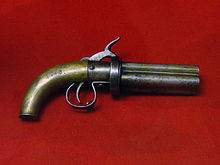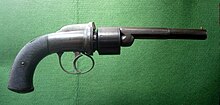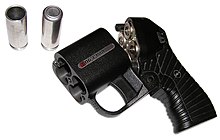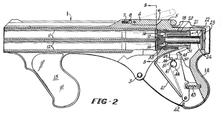Pepper-box: Difference between revisions
Caplock system wasn't invented until the early 19th century. "1763" is a serial number, not a date. |
|||
| Line 67: | Line 67: | ||
*In the 2012 [[Playstation]] [[Playstation Vita|Vita]] video game ''[[Assassin's Creed III: Liberation]]'', a pepper-box pistol is available to buy as a gun at the weaponry. The gun, itself, cost 100,000 [[écu]]; thus making the item the most expensive item in the entire game to purchase. |
*In the 2012 [[Playstation]] [[Playstation Vita|Vita]] video game ''[[Assassin's Creed III: Liberation]]'', a pepper-box pistol is available to buy as a gun at the weaponry. The gun, itself, cost 100,000 [[écu]]; thus making the item the most expensive item in the entire game to purchase. |
||
*In the 1972 U.S. edition of the [[Cluedo|Clue board game]], the "revolver" weapon token (and card) depict a pepperbox. |
*In the 1972 U.S. edition of the [[Cluedo|Clue board game]], the "revolver" weapon token (and card) depict a pepperbox. |
||
*The character of Leon portrayed by [[Brion James]] in the movie [[Blade Runner]] used a [[COP .357 Derringer]] pepperbox pistol |
|||
==References== |
==References== |
||
Revision as of 05:38, 23 February 2013
This article needs additional citations for verification. (November 2008) |

The pepper-box revolver or simply pepperbox (also "pepper-pot", from its resemblance to the household pepper grinder) is a multiple-barrel repeating firearm that has three or more barrels grouped around a central axis. It mostly appears in the form of a multi-shot handheld firearm. Pepperboxes exist in all ammunition systems: matchlock, wheellock, flintlock, percussion, pinfire, rimfire and centerfire.
The pepperbox should not be confused with a volley gun (like the seven-barrel long gun made by Nock), a firearm that fires multiple projectiles simultaneously by use of multiple barrels.[1] The difference is that a volleygun fires all the barrels simultaneously while the pepperbox is a repeater. Neither should it be confused with a firearm having multiple barrels next to each other (like the Jarre), which is known as a "Harmonica gun".[2] The pepperbox should also not be confused with or a development of the Gatling gun, which fires rapidly by the use of rotating multiple barrels.

Early years
This type of firearm was popular in North America from 1830 until the American Civil War, but the concept was introduced much earlier. In the 15th century, several single-shot barrels were attached to a stock, being fired individually by means of a match.
Around 1790, pepperboxes were built on the basis of flintlock systems, notably by Nock in England and "Segallas" in Belgium. These weapons, building on the success of the earlier two-barrel turnover[3] pistols, were fitted with three, four or seven barrels.[4] These early pepperboxes were hand-rotated.
The invention of the percussion cap by Joshua Shaw, building on Alexander Forsyth's innovations, and the industrial revolution allowed pepperbox revolvers to be mass-produced, making them more affordable than the early handmade guns previously only seen in the hands of the rich. Examples of these early weapons are the English Budding (probably the first English percussion pepperbox), the Swedish Engholm and the American threebarrel Manhattan pistol.
Popularity


The pepperbox, at least the firearm that is mostly associated with this term, was invented in the 1830s and was meant mainly for civilian use. It spread rapidly in the United Kingdom, the USA and some parts of continental Europe. It was similar to the later revolver in that it contained bullets in separate chambers in a rotating cylinder. Unlike the revolver, however, each chamber had its own barrel, making a complex indexing system unnecessary (though pepperboxes with such a system do exist).[5]
A few percussion pepperboxes were still hand-rotated but most have a mechanism that rotates the barrel group as the hammer is cocked for each shot. Single-action versions were made, notably by Darling of Massachusetts, but the vast majority use the self-cocking system whereby squeezing the trigger rotates the barrel block, cocks the hammer and finally fires the weapon. (Sometimes called "double action", although this term is more properly used for later revolvers that can be fired either in single-action or in self-cocking mode.) The main producer of self-cocking top-hammer pepperboxes (mostly referred to as "bar-hammer pepperbox") in the USA was Ethan Allen, but this type of weapon was also produced in very large quantities in England.[4]
Some pepperboxes fired the lower barrel instead of the upper, such as the Belgian Marriette (in configurations with between 4 and 24 barrels), the American Blunt and Syms or the English Cooper. Usually these employed an "underhammer" action, with the hammer mounted under the frame, behind the barrels, forward of the trigger (often a ring-trigger). Several other types of firing mechanisms exist, like rotating internal firing pins (Robbins and Lawrence, Comblain), rotating firing pins on a hammer (Sharps, Grunbaum)[6] or multiple firing pins (Martin).
The flaw with the pepperbox is that it becomes more front-heavy if the length and number of barrels is increased which makes accurate aiming difficult. With most types, in particular those with rotating barrel-clusters, it is almost impossible because the hammer is in the line of sight (some pepperboxes have a slot in the hammer through which one is supposed to aim), there is no place to put a frontsight, and the gun is too front-heavy to permit quick and steady aiming. However, the primary market was for civilian self-defense so its most common use was at close range. Common practice at the time, indeed, was not to aim pistols, but instead to "shoot from the hip," holding the gun low and simply pointing at the target's center of mass. Gunfights often happened at point-blank range. With this use in mind, many pepperboxes, in fact, have smooth-bored barrels, even though rifling had been commonly used for decades by the time of their manufacture. Pepperboxes with rifled barrels do exist, however, particularly the ones from the pinfire era.
Multi-shot percussion firearms were often considered dangerous because firing one powder charge could ignite the others (a "chainfire"), all at the same time, when proper care was not taken. This problem was largely eliminated by the introduction of nipple partitions, evident on later percussion revolvers, which largely shielded the percussion caps on neighbouring chambers from the flash struck by the weapon's hammer during firing. However this feature is rarely seen on pepperboxes, although some had the nipples placed in recesses or at right angles to each other to reduce the chance of a chainfire. In a pepperbox this would be less dangerous than when the same thing happened in a single-barreled revolver because in the pepperbox, at least, all the bullets could freely exit the muzzle. Similarly if a chamber wasn’t in exactly the right position when the hammer hit the cap it would fire normally and safely. This simplicity and safety helped the pepperbox survive after more modern revolvers came along, as well as keeping production costs a lot lower than revolvers with their more complex mechanisms.
Transitional revolver

A development from the pepperbox is the so-called "transitional" revolver. This weapon uses the same action but with one single barrel attached to the front of a cut-down pepperbox cylinder. A transitional revolver is defined as a revolver (with barrel and cylinder) that does not have a cylinder-stop, an early example being the Collier flintlock revolver of 1819.[7]

It retained the pepperbox's caplock action but still had many deficiencies. The lack of an effective cylinder stop allowed a charge to be fired when the cylinder wasn’t aligned with the barrel, resulting in an erratic shot possibly damaging the gun and even injuring the firer. While the shortened cylinder made loading easier the barrel was attached to the cylinder pin; over time this weakened the gun, decreasing its accuracy. In addition it lacked partitions between its nipples, risking similar chain-fires to the earlier pepperbox. This was exacerbated by the fact that the bar-hammers common on pepperboxes and transitional revolvers usually provided a weak blow, which meant that extra-sensitive percussion caps were needed to ensure that the gun would fire, further increasing the risk of a chain-fire.[8] Although later models were fitted with a shield to protect the user from cap fragments there was still a risk of being maimed or killed as a multiple discharge could cause the gun to explode.[9]
Since the bullets didn't have to be rammed down from the muzzle but were loaded into the cylinder behind the barrel, they could be slightly larger than the bore, which facilitated the use of rifled barrels. Whereas most pepperboxes are smooth-bore, most transitionals are rifled.
Daniel Leavitt was the subject of a famous lawsuit after producing a transitional revolver in 1851 with an identical loading lever to the Colt Dragoon.[10] Guns of this type saw use in the Mexican War as an alternative to the Colt Walker and Dragoon, most notably by General Winfield Scott.[11] Pepperboxes and transitional revolvers started disappearing gradually in the 1850s with the manufacture of true revolvers by Samuel Colt, Webley, Robert Adams, Smith and Wesson, Jacob Rupertus and others.
Revival

The pepperbox experienced a kind of "revival" in the late 19th century as a short, easily concealable pocketweapon that used pinfire cartridges. A special variation of this kind of handgun, in which the shortness of the barrel cluster was fully utilized, is the French "Apache revolver." This weapon, allegedly popular among Paris street gangs, was fitted with a folding blade and knuckle-duster.[12] The pepperboxes from this period disappeared with the demise of the pinfire cartridge.
The Christian Sharps 4-barrel derringer was another pepperbox that survived into the late 19th century. Like contemporary pistols including the Colt Thuer and 2-barrel Remington, it had a sheath trigger that appeared when the hammer was cocked. Cartridges were loaded into this 4-shot gun by sliding the barrels forward. It first appeared in 1859 and was used by many soldiers during the Civil War, remaining in production until 1874. After the war it became popular in the Old West among lawmen, outlaws and gamblers as its small size allowed it to be concealed in a waistcoat pocket.[13]
The Swedish five-barrel Feilitzenre pistol is the only pepperbox that was ever taken into consideration for use by an army. In the late 19th century many British officers used the privately purchased 4-barrel Lancaster pistol in preference to the standard-issue Beaumont-Adams and Webley revolvers as it had greater stopping power, a faster rate of fire and was quicker to reload.[14] This break-action pepperbox, available in calibers as large as .476 (with even a double barrel version in caliber .577 available) worked in a similar way to the Sharps Pocket Pistol: its striker, not the barrels, revolved.[15]

Modern use


The pepperbox design was used for a small number of weapon designs in the 20th century. In 1920, Mossberg produced the Mossberg Brownie, a 4-barrel .22LR pocket-pistol marketed to trappers. In the 1970s, the COP 357 Derringer was produced as a backup weapon for police officers.
The 5 barrel Neal submachine gun of the 1940s is a pepperbox derivarive using rotating barrels much like a gatling. This weapon is capable of firing 3000rpm.
Heckler & Koch used the pepperbox concept for their underwater P11 pistol.[16]
While pepperboxes were usually handguns, a few rifle-sized guns were made; Samuel Colt owned a revolving 3-barrel matchlock musket from India,[17] and the Colt Defender, a pepperbox rifle designed by Robert Hillberg, which utilized 3-inch 20-gauge magnum rounds and had 8 barrels which rotated around a central axis. One version of the Defender also had a receptacle for a tear-gas canister between the barrels.
Modern pepperbox shotguns include the FAMARS Rombo[18] and the double-action 4-barrel Winchester Liberator, which was developed by Robert Hillberg prior to his work on the Defender. The Liberator was designed as an anticommunist insurgency weapon before being adopted by some US police forces and was named after its spiritual ancestor, the Liberator Pistol.
In today's media
- In the 2012 Playstation Vita video game Assassin's Creed III: Liberation, a pepper-box pistol is available to buy as a gun at the weaponry. The gun, itself, cost 100,000 écu; thus making the item the most expensive item in the entire game to purchase.
- In the 1972 U.S. edition of the Clue board game, the "revolver" weapon token (and card) depict a pepperbox.
- The character of Leon portrayed by Brion James in the movie Blade Runner used a COP .357 Derringer pepperbox pistol
References
- ^ Harper's Nock Volley Gun
- ^ Jonathan Browning , Mormon gunsmith. . Retrieved Nov 6, 2008.
- ^ The New Weapons of the World Encyclopedia: An International Encyclopedia from 5000 B.C. to the 21st Century By Diagram Group, (Macmillan, 2007) p.126
- ^ a b The Pepperbox Revolver
- ^ 'American, British & Continental Pepperbox Firearms' by Jack Dunlap, recorder Sunset Press, San Francisco, 1964
- ^ Sharps pepper-box pistol 1859–1874
- ^ Howard RIcketts, Firearms (London, 1962)
- ^ Jeff Kinard, Pistols: An Illustrated History of Their Impact (2004) p.63
- ^ .Jeff Kinard (2004). Pistols: An Illustrated History of Their Impact p.65.
- ^ The Guns that Won the West: Firearms on the American Frontier, 1848–1898, John Walter, MBI Publishing Company, 2006, ISBN 1-85367-692-6
- ^ Pistols with pedigrees
- ^ Hell In A Handbasket
- ^ Myatt, F, 19th century Firearms p.162
- ^ # ^ Myatt, F, 19th century firearms (London 1989)
- ^ * Maze, Robert J. Howdah to High Power. Tucson, Arizona: Excalibur Publications, 2002. ISBN 1-880677-17-2.
- ^ "Heckler & Koch HK P11 Underwater Pistol". Modern Firearms. Retrieved March 29, 2008.
- ^ Cooper, C, Samuel Colt: Arms, Art, and Invention (2006) p.26
- ^ Famars shotguns including the Rombo
Bibliography
- The Pinfire Pepperbox Explained by Gerard Henrotin (H&L Publishing / HLebooks.com – 2009)
- Pinfire Revolvers Explained by Gerard Henrotin (H&L Publishing / HLebooks.com – 2010)
External links
![]() Media related to Pepper-box at Wikimedia Commons
Media related to Pepper-box at Wikimedia Commons
